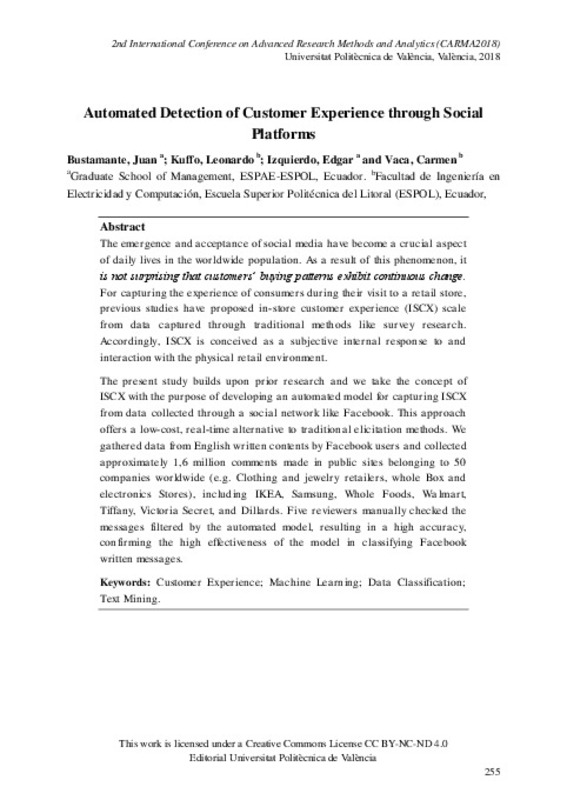JavaScript is disabled for your browser. Some features of this site may not work without it.
Buscar en RiuNet
Listar
Mi cuenta
Estadísticas
Ayuda RiuNet
Admin. UPV
Automated Detection of Customer Experience through Social Platforms
Mostrar el registro sencillo del ítem
Ficheros en el ítem
| dc.contributor.author | Bustamante, Juan
|
es_ES |
| dc.contributor.author | Kuffo, Leonardo
|
es_ES |
| dc.contributor.author | Izquierdo, Edgar
|
es_ES |
| dc.contributor.author | Vaca, Carmen
|
es_ES |
| dc.date.accessioned | 2018-11-06T08:06:43Z | |
| dc.date.available | 2018-11-06T08:06:43Z | |
| dc.date.issued | 2018-09-07 | |
| dc.identifier.isbn | 9788490486894 | |
| dc.identifier.uri | http://hdl.handle.net/10251/111934 | |
| dc.description | Resumen de la comunicación | es_ES |
| dc.description.abstract | [EN] The emergence and acceptance of social media have become a crucial aspect of daily lives in the worldwide population. As a result of this phenomenon, it is not surprising that customers’ buying patterns exhibit continuous change. For capturing the experience of consumers during their visit to a retail store, previous studies have proposed in-store customer experience (ISCX) scale from data captured through traditional methods like survey research. Accordingly, ISCX is conceived as a subjective internal response to and interaction with the physical retail environment. The present study builds upon prior research and we take the concept of ISCX with the purpose of developing an automated model for capturing ISCX from data collected through a social network like Facebook. This approach offers a low-cost, real-time alternative to traditional elicitation methods. We gathered data from English written contents by Facebook users and collected approximately 1,6 million comments made in public sites belonging to 50 companies worldwide (e.g. Clothing and jewelry retailers, whole Box and electronics Stores), including IKEA, Samsung, Whole Foods, Walmart, Tiffany, Victoria Secret, and Dillards. Five reviewers manually checked the messages filtered by the automated model, resulting in a high accuracy, confirming the high effectiveness of the model in classifying Facebook written messages. Keywords: Customer Experience; Machine Learning; Data Classification; Text Mining. | es_ES |
| dc.format.extent | 1 | es_ES |
| dc.language | Inglés | es_ES |
| dc.publisher | Editorial Universitat Politècnica de València | es_ES |
| dc.relation.ispartof | 2nd International Conference on Advanced Reserach Methods and Analytics (CARMA 2018) | es_ES |
| dc.rights | Reconocimiento - No comercial - Sin obra derivada (by-nc-nd) | es_ES |
| dc.subject | Web data | es_ES |
| dc.subject | Internet data | es_ES |
| dc.subject | Big data | es_ES |
| dc.subject | QCA | es_ES |
| dc.subject | PLS | es_ES |
| dc.subject | SEM | es_ES |
| dc.subject | Conference | es_ES |
| dc.subject | Customer experience | es_ES |
| dc.subject | Machine learning | es_ES |
| dc.subject | Data classification | es_ES |
| dc.subject | Text mining | es_ES |
| dc.title | Automated Detection of Customer Experience through Social Platforms | es_ES |
| dc.type | Capítulo de libro | es_ES |
| dc.type | Comunicación en congreso | es_ES |
| dc.identifier.doi | 10.4995/CARMA2018.2018.8347 | |
| dc.rights.accessRights | Abierto | es_ES |
| dc.description.bibliographicCitation | Bustamante, J.; Kuffo, L.; Izquierdo, E.; Vaca, C. (2018). Automated Detection of Customer Experience through Social Platforms. En 2nd International Conference on Advanced Reserach Methods and Analytics (CARMA 2018). Editorial Universitat Politècnica de València. 255-255. https://doi.org/10.4995/CARMA2018.2018.8347 | es_ES |
| dc.description.accrualMethod | OCS | es_ES |
| dc.relation.conferencename | CARMA 2018 - 2nd International Conference on Advanced Research Methods and Analytics | es_ES |
| dc.relation.conferencedate | Julio 12-13,2018 | es_ES |
| dc.relation.conferenceplace | Valencia, Spain | es_ES |
| dc.relation.publisherversion | http://ocs.editorial.upv.es/index.php/CARMA/CARMA2018/paper/view/8347 | es_ES |
| dc.description.upvformatpinicio | 255 | es_ES |
| dc.description.upvformatpfin | 255 | es_ES |
| dc.type.version | info:eu-repo/semantics/publishedVersion | es_ES |
| dc.relation.pasarela | OCS\8347 | es_ES |








